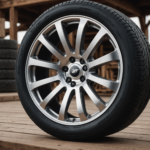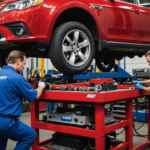The relationship between climate and tire selection might not be immediately obvious to every car enthusiast or driver. However, understanding how different weather conditions impact tire performance, durability, and safety is essential for anyone looking to optimize their vehicle’s fitment. This article explores the multifaceted ways in which climate plays a pivotal role in tire selection and fitment.
The Importance of Choosing the Right Tires
Tires are one of the most critical components of a vehicle, directly affecting performance, safety, and fuel efficiency. When it comes to tire selection, one of the first considerations should be the climate in which the vehicle will primarily operate. Selecting the correct tire type based on climate conditions can significantly enhance driving safety and vehicle longevity. Below, we examine how various climate conditions influence the types of tires that are most appropriate for different driving needs.
Climate and Its Varied Effects on Tires
1. Hot Climates
In regions characterized by high temperatures, such as deserts or tropical locations, tire performance can be affected in several ways:
- Increased Wear: The heat from the asphalt can lead to increased wear rates, particularly on softer tire compounds.
- Tire Pressure Management: High temperatures can increase tire pressure, which can result in reduced traction and increased risk of blowouts.
- Recommended Tire Types: Summer tires and all-season tires with specialized compounds designed for warm conditions tend to perform best.
2. Cold Climates
In contrast, cold climates present a unique set of challenges for tire selection:
- Reduced Flexibility: Cold temperatures can cause tire rubber to harden, making tires less flexible and reducing grip on icy surfaces.
- Winter Conditions: Snow and ice require specialized tires to ensure safety, such as winter tires or studded tires.
- Recommended Tire Types: Winter tires are equipped with deeper treads and softer rubber compounds that remain pliable in low temperatures, providing better traction.
3. Wet Climates
Regions with consistent rainfall require careful tire considerations for optimal performance:
- Aquaplaning Risk: Wet roads increase the likelihood of aquaplaning, necessitating tires with grooves designed to channel water away from the contact patch.
- Traction Needs: Tires that feature a unique tread pattern can enhance wet traction while reducing braking distances.
- Recommended Tire Types: All-season tires with advanced tread technology or dedicated rain tires provide superior performance in wet conditions.
4. Mixed Climates
For regions that experience diverse weather conditions throughout the year, having the right set of tires is crucial:
- Seasonal Tire Changes: Drivers in mixed climates often benefit from switching between winter and summer tires.
- All-Season Tires: While all-season tires provide versatility, they may not always perform optimally in extreme conditions, either hot or cold.
Understanding Tire Specifications
To make informed decisions about tire selection, understanding tire specifications is essential. The following components should be considered:
| Tire Specification | Description |
|---|---|
| Width | The tire’s width measured in millimeters. Wider tires may provide better stability but can increase rolling resistance. |
| Aspect Ratio | The ratio of the tire’s height to its width, expressed as a percentage. A lower aspect ratio typically means better handling, while a higher aspect ratio emphasizes comfort. |
| Diameter | The diameter of the wheel the tire fits. It’s crucial for ensuring tire and wheel compatibility. |
| Load Index | This number indicates the maximum load a tire can carry. Understanding it is vital for ensuring tires can support the vehicle’s weight. |
| Speed Rating | The maximum speed a tire can safely maintain over time. Selecting a tire with the appropriate speed rating based on driving habits is essential. |
The Mathematical Relationship: Tire Pressure and Climate
Another critical area where climate impacts tire performance is tire pressure. The relationship between tire pressure and temperature can be understood through the Ideal Gas Law:
Formula:
PV = nRT
- P: Pressure in Pascals
- V: Volume of the tire (assumed constant)
- n: Number of moles of air
- R: Universal gas constant
- T: Temperature in Kelvin
As temperature rises, tire pressure increases, while lower temperatures lead to reduced pressure. For every 10°C (18°F) change in temperature, tire pressure can vary by approximately 1 psi. Thus, regular tire pressure checks are essential for optimal safety and performance throughout seasonal transitions.
Seasonal Tire Maintenance and Climate Considerations
Regardless of climate, regular tire maintenance can greatly enhance performance and lifespan. Below is a checklist of essential maintenance practices:
- Regular Pressure Checks: Monitor tire pressure at least once a month, adjusting according to seasonal temperature shifts.
- Tread Depth Monitoring: Ensure tread depths are sufficient for safe driving, particularly in wet or snowy conditions.
- Rotation and Alignment: Rotate tires regularly and check wheel alignment to promote even wear.
- Visual Inspections: Regularly inspect tires for signs of damage, including cracks, bulges, and foreign objects.
- Seasonal Swaps: Change tires based on the climatic conditions—switching between winter and summer or all-season as necessary.
Conclusion: A Tailored Approach to Tire Selection
Understanding how climate affects tire selection and fitment is crucial for enhancing vehicle performance and safety. By recognizing the unique challenges posed by different weather conditions, drivers can make informed decisions that not only improve their driving experience but also prolong the life of their tires. Whether navigating hot sun-soaked days, treacherous snowy roads, or damp rainy stretches, the right tire choice holds the potential to transform driving safety and efficiency.
In summary, take into account the specific environmental conditions where driving will predominantly occur and select tires that are equipped to handle those challenges for optimal safety, performance, and comfort.
This article incorporates various elements like tables, lists, and formulas while providing a comprehensive overview of how climate impacts tire selection and fitment.




















